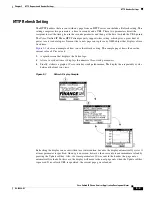
C H A P T E R
5-1
Cisco Unified IP Phone Services Application Development Notes
OL-18696-01
5
HTTP Requests and Header Settings
Cisco Unified IP Phones use HTTP to communicate to external applications. The phone firmware
includes both an HTTP client for making requests, and an HTTP server for receiving requests. This
chapter describes the capabilities of the HTTP interface.
This chapter contains the following sections:
•
HTTP Client Requests (HTTP GET)
•
HTTP Server Requests (HTTP POST)
•
HTTP Header Settings
•
Identifying the Capabilities of IP Phone Clients
•
Accept Header
•
Accessing IP Phone Information
HTTP Client Requests (HTTP GET)
The following description designates how HTTP client requests are handled:
1.
The Cisco Unified IP Phone HTTP client performs an HTTP GET for a specified URL.
2.
The HTTP server processes request and returns an XML object or plain text.
3.
The phone processes the supported HTTP headers.
4.
The phone parses the XML object if ContentType is
text/xml
.
5.
The phone presents data and options to the user, or in the case of a CiscoIPPhoneExecute object,
begins executing the URIs.
HTTP Server Requests (HTTP POST)
The following description designates how an HTTP server request is made to the phone via an HTTP
POST operation:
1.
The server performs an HTTP POST in response to a case-sensitive URL of the phone with this
format: http://
x.x.x.x
/CGI/Execute, where
x.x.x.x
represents the IP address of the destination
Cisco Unified IP Phone.
















































